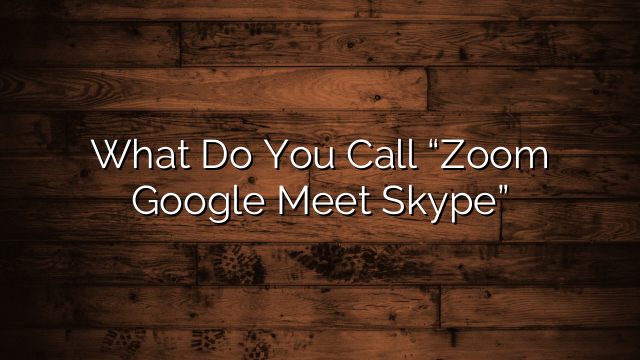In this era of advanced technology, it seems that our vocabulary has expanded to include a myriad of names for video conferencing platforms.
From the ubiquitous ‘Zoom’ to the corporate-friendly ‘Google Meet’ and the long-standing ‘Skype,’ these virtual communication tools have become an integral part of our lives.
Ironically, despite their distinct names, they all serve a common purpose – facilitating online meetings and connecting people from different corners of the world.
As we delve into the depths of this article, we will explore not only the popular video conferencing platforms but also the evolution of online communication itself.
We will examine their features and functions, discussing how they have revolutionized remote work and brought us closer together in unprecedented ways.
Moreover, we will provide insights to help you choose the right platform that suits your specific needs.
So let us embark on this journey through the realm of virtual connectivity and discover what lies beyond these familiar names.
Key Takeaways
- Advanced technology has expanded the vocabulary for video conferencing platforms.
- Zoom, Google Meet, and Skype are popular video conferencing platforms that facilitate virtual meetings and connections.
- Each platform has its own strengths and weaknesses in terms of video quality, security, and privacy.
- Personal preferences and cultural differences influence the way people refer to these platforms.
Popular Video Conferencing Platforms
Popular video conferencing platforms include Zoom, Google Meet, and Skype. These platforms have gained significant popularity due to their ease of use and ability to connect people from different locations through video calls.
One important aspect when comparing these platforms is the video quality they provide. Zoom has been praised for its high-definition video quality, offering clear and crisp visuals during conferences. Google Meet also delivers a good video quality experience, although it may not be as sharp as Zoom’s. Skype offers satisfactory video quality but has faced criticism for occasional pixelation or blurriness.
Another factor to consider is security and privacy concerns. Zoom has faced scrutiny regarding its security measures in the past, leading to updates that address vulnerabilities and enhance user privacy. Google Meet provides strong encryption standards to protect sensitive information shared during meetings. Skype also employs encryption techniques but has encountered some privacy issues in the past.
Overall, while all three platforms offer reliable video conferencing capabilities, users should consider their specific needs regarding video quality and security before choosing one over the others.
The Names People Use
Widely utilized video communication platforms often go by the names of these three prominent tech companies: Zoom, Google Meet, and Skype. These platforms have become integral to online communication habits in today’s digital age. Each platform has its own distinct features and user interface, catering to different preferences and needs.
Interestingly, cultural differences can be observed in the way people refer to these platforms. In some regions, people may use generic terms such as ‘video call’ or ‘online meeting’ without specifically mentioning any platform name. This might reflect a lack of brand dominance or a preference for simplicity in naming conventions.
On the other hand, certain cultures tend to adopt specific platform names more commonly due to factors like brand recognition or marketing strategies employed by the respective companies.
Overall, the varied ways people refer to these video conferencing platforms highlight the global impact they have made on modern communication practices.
The Evolution of Online Communication
The progression of online communication has seen a transformative shift over time. Advancements in technology have paved the way for various platforms such as Zoom, Google Meet, and Skype, which have revolutionized the way people interact and communicate with one another.
These platforms allow individuals to connect with others from different parts of the world, breaking down geographical barriers and enabling seamless communication. Online communication has significantly impacted social interaction by providing opportunities for virtual meetings, conferences, and collaborations. It has fostered global connections and facilitated knowledge sharing on a large scale.
However, it is important to note that while online communication offers convenience and accessibility, it may also lead to a decrease in face-to-face interactions and potentially affect the quality of personal relationships. As online communication continues to evolve, its impact on social interaction will continue to be studied and understood.
Features and Functions
One notable aspect of online communication is its ability to facilitate virtual interactions and collaborations, allowing individuals to connect with others from different parts of the world and breaking down geographical barriers.
Online communication platforms such as Zoom, Google Meet, and Skype offer a range of features that enhance the user experience. These platforms allow users to schedule and host meetings, share screens, exchange files, and communicate through audio and video channels. When comparing these platforms’ features, it becomes evident that they have similar functionalities but may differ in terms of ease of use or specific capabilities.
Furthermore, security measures are a crucial consideration for online communication platforms. They employ various encryption techniques to ensure data privacy and implement authentication protocols to prevent unauthorized access.
Overall, the features offered by these platforms enable seamless virtual communication while prioritizing security measures to protect users’ information.
Choosing the Right Platform
When choosing the right platform for virtual meetings, there are several considerations for business use that need to be taken into account. These include factors such as security features, ease of use, and compatibility with existing systems.
Additionally, personal preferences play a significant role in selecting a platform that suits individual needs and preferences.
Finally, implementing certain tips can help ensure a successful virtual meeting experience, such as testing the technology beforehand, creating an agenda, and providing clear instructions to participants.
Considerations for Business Use
Considerations for business use include the evaluation of features, security measures, and compatibility with existing systems when choosing among Zoom, Google Meet, and Skype.
Businesses must prioritize their security needs to ensure that confidential information remains protected during virtual meetings. It is important to assess the encryption protocols offered by each platform and determine if they meet industry standards.
Additionally, cost analysis plays a crucial role in decision-making. Businesses need to evaluate the pricing structures of each platform and consider factors such as the number of users, storage capacity, and additional features available at different price points.
Compatibility with existing systems is another key consideration as it ensures seamless integration without disrupting ongoing operations.
By carefully assessing these factors, businesses can make an informed choice that aligns with their specific requirements for business security and cost efficiency.
Personal Preferences
Personal preferences for virtual meeting platforms can be as diverse as the flavors in an ice cream shop, with individuals gravitating towards the platform that best suits their communication style and desired user experience.
When it comes to personal preferences, factors such as ease of use, reliability, and features play a significant role in determining which platform individuals prefer. Some may prefer Zoom due to its intuitive interface and robust features like screen sharing and breakout rooms. Others may choose Google Meet for its integration with other Google services and its simplicity. Meanwhile, Skype might appeal to those who value its long-standing reputation for video calling and familiarity.
Ultimately, personal preferences are subjective and dependent on individual needs and expectations. What matters most is finding a virtual meeting platform that aligns with one’s personal communication style and offers a satisfying user experience.
Tips for a Successful Virtual Meeting
To ensure the success of a virtual meeting, it is essential to implement effective strategies and techniques that promote engagement and collaboration among participants.
Effective communication plays a crucial role in maintaining the flow of ideas and information during virtual meetings. Participants should strive to clearly articulate their thoughts, utilizing concise language and avoiding unnecessary jargon. Additionally, active listening skills are vital for understanding others’ perspectives and fostering meaningful conversations.
Virtual etiquette also plays a significant role in creating a conducive meeting environment. Attendees should be mindful of their online behavior, ensuring proper video conferencing decorum by dressing professionally, minimizing distractions, and muting themselves when not speaking.
Moreover, adhering to scheduled meeting times demonstrates respect for everyone’s time and helps maintain focus throughout the session. By implementing these strategies, virtual meetings can be conducted successfully with effective communication and adherence to virtual etiquette principles.
Frequently Asked Questions
Can I use Zoom, Google Meet, or Skype for personal video calls?
Zoom, Google Meet, and Skype are widely used for personal video calls. An interesting statistic shows that Zoom experienced a 30x increase in daily participants during the pandemic. To optimize video call quality, ensure a stable internet connection and use appropriate lighting and audio equipment.
What are the main differences between Zoom, Google Meet, and Skype?
The main features of Zoom, Google Meet, and Skype differ in terms of video quality, participant capacity, and integration with other tools. Pros include ease of use and screen sharing options. Cons include security concerns and limited free versions.
Can I use any of these platforms for free?
These platforms can be used for free, but also offer paid versions with additional features. For those seeking alternative free video call platforms, options include Microsoft Teams, Cisco Webex, and Jitsi Meet.
Are there any limitations or restrictions when using Zoom, Google Meet, or Skype?
Limitations may exist when using video conferencing platforms like Zoom, Google Meet, and Skype. These may include restrictions on the number of participants or meeting duration. Additionally, video quality can vary among these platforms.
Are there any security concerns or privacy issues associated with Zoom, Google Meet, or Skype?
Security concerns and privacy issues are prevalent when using Zoom, Google Meet, or Skype. These platforms have faced numerous incidents of data breaches, unauthorized access to meetings, and inadequate encryption protocols, raising concerns about the safety of user information and conversations.
Conclusion
Popular video conferencing platforms such as Zoom, Google Meet, and Skype have revolutionized online communication. Each platform offers unique features and functions that cater to different needs. People refer to these platforms by various names, depending on their preference or familiarity. However, the ultimate goal is to choose the right platform that suits one’s requirements for effective virtual meetings and collaborations.
As technology continues to advance, the evolution of online communication brings us closer together in a world where distance is no longer a barrier.
In conclusion, choosing the right video conferencing platform plays a crucial role in enhancing virtual communication and collaboration. Whether it’s Zoom, Google Meet, or Skype, each platform has its own set of features that can meet diverse needs. As the saying goes, ‘A picture is worth a thousand words,’ these platforms enable us to connect visually with others across distances and foster meaningful interactions. Embracing these tools empowers individuals and organizations to bridge gaps and build stronger connections in today’s digital era.



